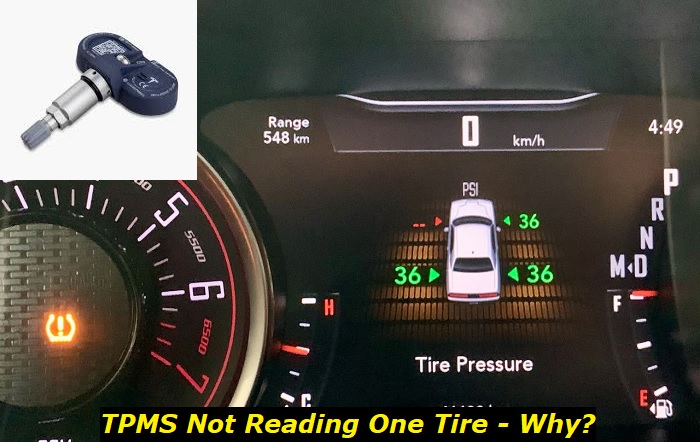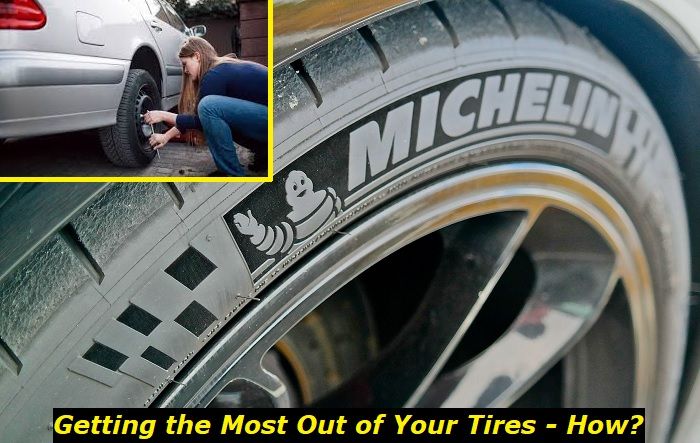The Tire Pressure Monitoring System (TPMS) is designed to alert the driver when the pressure of any one or all of the tires on the vehicle is too low as well as too high. Improper tire inflation can create unsafe driving conditions, often resulting in sudden tire blowouts or even rollover accidents. Whether a tire is overinflated or underinflated, both conditions can result in premature wear and possible tire failures which can easily force the driver to lose control of their vehicle.
Therefore, it can be a lifesaver to be aware of the importance of having accurate tire pressure and a properly functioning Tire Pressure Monitoring System (TPMS). The purpose of the TPMS is to monitor the actual air pressure of the tires on your vehicle.

By recognizing any potentially hazardous state of the tires at an early stage, the TPMS can help avoid premature wear-n-tear, poor fuel economy, and most importantly, life-threatening traffic accidents.
Although the TPMS indicator may be easy to find on your dashboard, figuring out the main culprit behind the TPMS not reading one tire may require a much closer look. All drivers need to understand and know what to do when the horseshoe-shaped TPMS warning light illuminates on the dashboard.
Being able to determine what's wrong and how to fix the TPMS when not reading one tire can help you to avoid unexpected and possibly dangerous situations on the road.
The Tire Pressure Monitoring System (TPMS)
By monitoring the air pressure inside of the tires on your vehicle, the TPMS is able to report actual real-time information on the tire pressure. This information is provided to the driver of the vehicle through either a pictogram display or a low-pressure warning light illuminating on the dashboard.
As a result of high accident rates due to overinflated and underinflated tires, the National Highway Traffic Safety Administration (NHTSA) has made it a mandatory requirement to be equipped with a TPMS for all vehicles (cars and light trucks) that are newer than 2008.
A TPMS can be installed both when the vehicle is being made by the manufacturer or after it has been put to use. If one or more tires has a PSI reading that falls under 25% of the vehicle's standard requirement or recommendation, the driver will be alerted of the unsafe tire pressure condition by the Tire Pressure Monitoring System (TPMS).
A TPMS symbol or warning light will appear if the ECU of your vehicle determines that a specific tire is at least 25% or more below or even above the recommended inflation pressure.
Direct and Indirect are the two types of Tire Pressure Monitoring Systems (TPMS) that are used in most vehicles. Both of the Tire Pressure Monitoring Systems keep track of the tire pressure within each individual tire and alert the driver of any hazardous tire pressure that may be capable of creating unsafe driving conditions.
However, although performing the same functions, the two systems monitor the tire pressure in two completely different ways.
- Direct TPMS
Used more often in the USA, the direct TPMS has sensors located in the tire pressure valve inside of each wheel. Being wrapped with a band clamp around the rim of the wheel and acting as an antenna, the sensors can transmit and accurately report the pressure data in real-time to the ECU of your vehicle.
However, these devices tend to not only corrode in harsh weather conditions but can also throw off and affect the balance of the tire.
- Indirect TPMS
The Indirect TPMS is more popular in Europe and has sensors on each wheel that can be found either within the ABS braking system or the speed sensors. Since tires are smaller and rotate faster if underinflated, these sensors monitor the speed of the wheel's rotations for any changes.
Even though these devices do not corrode nor have any effects on the balance of the tire, they have to be reset with a scanning tool any time tires are rotated and/or replaced.
What causes the TPMS to Fail to Read One Tire?
The Tire Pressure Monitoring System (TPMS) is responsible for monitoring the tire pressure and alerting the driver if the air is at a dangerous level in any one or all of the tires. The TPMS does so by mostly relying on TPMS sensors located inside each tire on the vehicle.
Once a TPMS sensor inside a tire detects any issues with the air pressure of that tire, the TPMS warning light will illuminate on the dashboard of your vehicle.
Whether your vehicle is equipped with a valve type or band sensor, both of these two common types of TPMS sensors are designed to send a signal if the reading of the air pressure is inaccurate.
The TPMS sensor continuously monitors the air pressure of each individual tire and transmits that data to the Powertrain Control Module (PCM) through a radio frequency signal. Although TPMS sensors are pretty durable with built-in batteries, they are certainly not immune to natural wear and tear and can malfunction for several reasons.
Depending on your model and year, some vehicles will inform you exactly which TPMS sensor is bad right on the dashboard. In other cases, your vehicle will let you know that a problem exists related to your TPMS, but you will have to properly diagnose and determine which is the faulty TPMS sensor that is failing to read a tire.
Furthermore, a code reader can be often used to diagnose the exact issue by plugging it into the computer of your vehicle.
Fortunately, TPMS sensors are attached to each individual tire responsible for monitoring that particular wheel. Therefore, if a TPMS sensor fails to read a tire and that sensor needs to be replaced, you can replace that TPMS sensor individually without affecting the other properly functioning sensors. Below are some common causes for a TPMS sensor to go bad and prevent the TPMS from reading one tire.
1) Corroded/Damaged Stems
Due to dirt buildup and other circumstances, the TPMS sensor's valve stems can corrode or get damaged. The integrity of the valve stem may be affected by corrosion or other damages and should be visually inspected. If corroded or physically damaged, the TPMS sensor in that specific tire may become faulty and completely fail to read the exact pressure.
2) Damaged Antenna/Faulty wiring
A damaged antenna near the wheel or faulty wiring between the antenna and the actual TPMS module can also cause the TPMS to malfunction. Even if the TPMS sensors are working properly, the signal from the sensors must get through to the TPMS module to transmit the data from each sensor to the module.
Without a good signal due to a damaged antenna or faulty wiring issues, the TPMS will fail to receive the air pressure information regarding that individual tire.
3) Low/Dead Batteries
The average lifespan of the battery inside of a TPMS sensor is anywhere between 5 to 10 years. Certain conditions such as stop-and-go traffic or simply transmitting more radio frequency transmission from excessive mileage can cause the lithium-ion batteries in a TPMS sensor to prematurely run low or die out.
If your TPMS sensor fails because of a dead battery, you will need to replace that individual TPMS sensor since the batteries inside of the sensors are not replaceable.
How to Diagnose and Fix the Issue
When the TPMS fails to read one tire, the TPMS warning light will appear on the dashboard of your vehicle. Just to make sure that the problem is not with the actual tires, first manually check the tire pressure of all four wheels to eliminate any improper tire inflation issues. If checking and even making any necessary adjustments to the tire pressure doesn't solve the issue, the TPMS sensors are the most likely culprit for this problem.
In the case of the TPMS not reading one tire, it is recommended to check the response signal using a TPMS tool from each tire pressure sensor. A TPMS tool will not only inform you whether or not each of the TPMS sensors is functional and capable of generating a signal, but also whether or not the pressure readings by each of the sensors are accurate.
Depending on the model and year of your vehicle, faulty TPMS sensors can be picked up by an OBD2 scanner or through the computer options on the dashboard.
Furthermore, it is crucial to know what type of relearn is required and relearn the TPMS once a sensor is replaced or when you have the tires rotated on your vehicle.
Although some vehicles have an auto-learn program, others may require you to use the manufacturer's process and put the vehicle into "Learn Mode" or use a TPMS scan tool. Regardless of the type of relearning needed, the TPMS must be relearned to upload the new sensor ID to your vehicle.
Conclusion
The Tire Pressure Monitoring System (TPMS) informs the driver if any of the tires on the vehicle are not inflated to the proper pressure to avoid unsafe driving conditions. If the TPMS is not reading one tire on your vehicle, it is usually safe to assume that the problem is the sensor on that particular wheel and that individual sensor may need to be replaced.
Since a faulty sensor is not reading the actual pressure on that tire, it is important to pay close attention to the tire pressure and deal with the issue immediately for your own safety and others on the road.
Also, it is recommended to check all of the tire pressure and the rest of the TPMS system to eliminate any other culprits behind the TPMS not reading one tire on your vehicle.
It is very common for the actual sensors to be functioning properly, yet fail to transmit the data due to weak signals because of a damaged antenna or faulty wiring. Just remember to relearn the TPMS once you replace a sensor as it is the process of uploading the new sensor ID to your vehicle.
About the authors
The CarAraC research team is composed of seasoned auto mechanics and automotive industry professionals, including individuals with advanced degrees and certifications in their field. Our team members boast prestigious credentials, reflecting their extensive knowledge and skills. These qualifications include: IMI: Institute of the Motor Industry, ASE-Certified Master Automobile Technicians; Coventry University, Graduate of MA in Automotive Journalism; Politecnico di Torino, Italy, MS Automotive Engineering; Ss. Cyril and Methodius University in Skopje, Mechanical University in Skopje; TOC Automotive College; DHA Suffa University, Department of Mechanical Engineering






Add comment